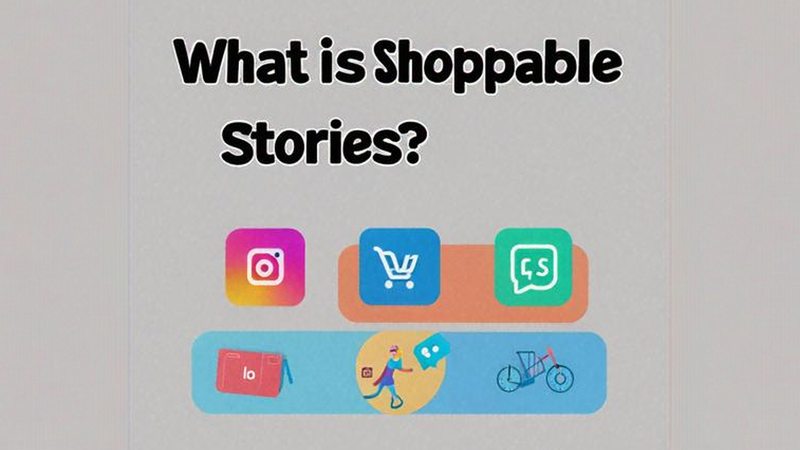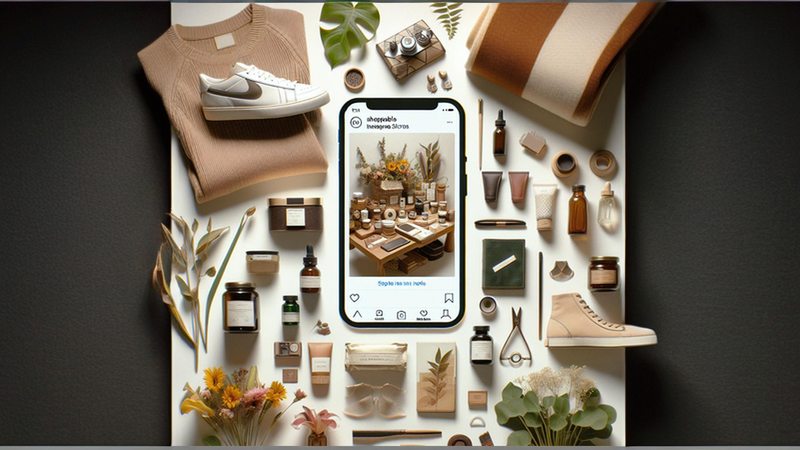How many times have you seen something on social media and immediately thought, “I want that”? It happens to everyone. In 2018, Instagram leveraged that impulse by introducing Shopping on Instagram. The feature has changed over time (you now click a sticker instead of swiping up), but the value remains the same – if anything, it’s better than ever.
Setting it up is straightforward, but you need a solid strategy to generate more sales. In this guide, we’ll cover the basics and the tactics that make shoppable Instagram Stories a success.
What is Instagram Shoppable Stories?

Shoppable Instagram Stories is an Instagram ecommerce feature that allows businesses to add product stickers or shopping tags to their stories. When users view a story with a product sticker, they can tap on it to see more details about the product, such as its name, price, and description.
Additionally, there’s usually a direct link that users can tap to purchase the product directly from the business’s website, making the shopping experience seamless and integrated directly into the Instagram platform.
This feature is part of Instagram’s broader set of shopping tools designed to make it easier for businesses to showcase their products and for users to shop directly within the app. You can grant permission for everyone or only approved branded content partners to tag products from your shop in their Instagram content too.
What Kind of Products Can You Sell on Instagram Stories?
You can sell a wide range of products on Instagram Stories, practically anything that complies with Instagram’s commerce policies. However, people need to be obvious about what they’re buying. If you want to make Instagram content shoppable, focus on a perfect balance between clarity and creativity.
Benefits of Instagram Shoppable Stories
You want to meet consumers where they are, and most of them won’t open your website daily, at least not unprompted. What they will open is Instagram. And by they, we mean the 500 million people who use Instagram Stories daily.
Here are some reasons why it’s worth adding shoppable tags to your IG stories.
- Direct sales channel: it provides a direct path from discovery to purchase, making it easier for consumers to buy products the moment they feel inspired. A simple tap can take them straight to a product page.
- Enhanced customer experience: the seamless integration of shopping features within Instagram Stories enhances the user experience, making shopping spontaneous and fun. This immediacy can significantly boost customer satisfaction and engagement.
- Increased Reach and Visibility: Stories are prominently displayed at the top of followers’ feeds, ensuring high visibility. Utilizing shoppable tags in these stories can capture the attention of potential customers as they browse through their daily stories.
How to Make Your Instagram Stories Shoppable

Follow these simple steps to create shoppable Instagram Stories that drive conversions and sales. Learn the exact steps on how to make your Instagram Stories Shoppable.
Step 1: Set Up Your Instagram Shop
Create an Instagram Shop based on Instagram shopping guidelines. The most important things to do here are:
- Make sure your business is approved for Instagram Shopping. You’ll see how to confirm approval in the guidelines.
- Set up an Instagram shop and link your product catalog.
- Ensure your account is active and follows Instagram’s policies.
Step 2: Add Product Stickers to Instagram Stories
- Open your story:
- Tap the “+” icon or your profile picture to create a new story.
- Choose a photo or video to upload.
- Add product stickers:
- Tap the sticker icon in the top right corner.
- Select the product sticker from the sticker tray.
- Tag your products:
- Choose the collection, storefront, or specific products from your catalog that you want to feature.
- Tap “Done” to confirm your selection.
- Position your sticker:
- Move the product sticker to your desired spot on the story.
- Adjust the size and style of the sticker by tapping it.
- Select your audience:
- Tap “Send To” and choose your audience (e.g., “Your Story” or “Close Friends”).
- Share your story:
- Tap “Share” to publish your shoppable story.
Step 3: Enable Followers to Share Your Products
When you enable followers to tag your products, you’re turning them into brand advocates. This organic promotion can significantly boost your visibility and credibility.
Plus, seeing your products in real-life contexts can help potential customers envision themselves using your products, increasing the likelihood of purchase. Here’s how to set it up:
Steps to Enable Followers to Share Your Products:
- Go to settings:
- Open the Instagram app and go to your profile.
- Tap the three horizontal lines in the top right corner to open the menu.
- Select “Settings.”
- Set up shopping:
- In Settings, tap “Business” or “Creator” (depending on your account type).
- Select “Shopping.”
- If you don’t see “Shopping,” make sure your account is approved for Instagram Shopping and that your product catalog is connected.
- Approve tagging permissions:
- In the Shopping settings, you’ll see options for tagging permissions.
- Choose “Allow All” if you want everyone to tag your products.
- Alternatively, select “Only Approved Accounts” to control who can tag your products. You can approve or deny requests from here.
- Manage tags:
- Monitor the tags on your products to ensure they align with your brand.
- If you find any inappropriate or incorrect tags, you can remove them directly from the tagged posts.
How to Drive Sales With Shoppable Instagram Stories
Making your Instagram Stories shoppable is just the first step. If you want to get more sales on Instagram, you need a strategic approach. Here are a few practical tips to help.
1. Highlight User Experiences
Show real customers using your products. This adds authenticity and builds trust. Share their stories so viewers can see and buy what others love.
User-generated content can be a powerful part of your overall marketing strategy, showing potential customers real-life applications of your products.
2. Tease New Products
Build anticipation for new launches with Instagram Stories. Use stories to give sneak peeks and exclusive previews and run preorder sales for early revenue.
This not only excites your current followers but also encourages them to share with their networks, expanding your reach. Create a sense of exclusivity that makes your audience feel special and eager to buy.
3. Run Flash Sales
Create urgency with limited-time offers. Announce flash sales in your stories with clear deadlines. This tactic drives immediate action and can significantly boost your sales in a short period. It’s an excellent way to clear out inventory or promote a new product quickly.
4. Integrate With Your Overall Sales Strategy
Make shoppable Instagram Stories a part of your larger sales strategy. Align your story content with your broader marketing campaigns. Use data from your stories to inform other marketing efforts. For example, if a particular product performs well in stories, feature it more prominently in email campaigns or on your website.
5. Track Performance and ROI
Use Instagram’s analytics to track the performance of your shoppable stories. Look at metrics like engagement rates, click-through rates, and conversions. This data helps you understand what works and what doesn’t, allowing you to refine your strategy and improve your ROI over time.
How to Make Your Shoppable Instagram Stories Stand Out: According to Meta
Of course, just adding a sticker to your stories isn’t enough to truly generate more sales. Here are five tips based on research from Meta on successful Instagram Stories ads:
1. Relevance Matters
According to Meta’s research, top-performing Instagram Stories ads ranked higher on relevance. This means the content must grab attention quickly, be easy to understand, and fit your brand’s message. Start with a clear value proposition to ensure viewers know what to expect right away.
2. Every Second Counts
Meta found that top-performing ads in stories were shorter and contained branding earlier. Aim to make your message clear within the first few seconds. Place your branding early to ensure it gets noticed before viewers potentially swipe away.
3. Fast Pacing Pays Off
For ads with multiple scenes, shorter scenes performed better. Meta’s study shows that fast pacing keeps viewers engaged. Try to keep each scene under three seconds to maintain a dynamic and engaging flow.
4. Product Demos Boost Results
Showing your product in use can significantly increase engagement. Meta’s data indicates that ads that demonstrate the product perform better on key metrics. Include a quick demo to highlight your product’s benefits and features effectively.
5. Optimize for Mobile
Nearly half of the ads tested by Meta were built specifically for Instagram Stories. Ensure your ads are mobile-optimized by using vertical video formats and keeping text concise and readable on smaller screens. This approach maximizes engagement and effectiveness.
Common Misconceptions about Shoppable Instagram Stories
Let’s dispel some common myths that stop e-commerce businesses from tapping into Shoppable Instagram Stories for their online stores.
1. They’re Only for Big Brands
Even small businesses can leverage shoppable stories effectively. Small businesses can use their unique brand story and personalized approach to connect with their audience. By showcasing behind-the-scenes content or sharing customer testimonials, small brands can create authentic and engaging stories that resonate with viewers. Shoppable stories are a great way to highlight limited-edition products or special offers that can drive immediate sales.
2. They’re Too Complicated to Set Up
If you can post on Instagram, you can make it shoppable. Instagram provides straightforward tools and resources to help you set up shoppable stories easily. The platform guides you through the process of setting up a shop, adding product stickers, and managing tags. You don’t need to be a tech expert to get started. If you need a little extra help, there are plenty of online tutorials and support forums where you can find step-by-step instructions and troubleshooting tips.
3. They’re Only for Physical Products
Digital products, services, and experiences can also be featured in shoppable stories. If you offer online courses, webinars, software, or any digital product, you can use shoppable stories to promote these offerings. For example, you can create a story that includes a product sticker for a downloadable e-book or a sign-up link for a virtual event. This allows you to reach a wider audience and generate interest in your digital products.
Embed Instagram Stories on Your Website
A great way to extend the reach of your shoppable stories is to embed Instagram Stories directly on your website using Juicer’s Instagram aggregator.
This not only keeps your website content fresh but also allows visitors to interact with your Instagram content without leaving your site. Ready to take your Instagram marketing to the next level? Explore Juicer’s pricing plans to enhance your social media strategy.
